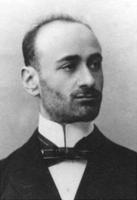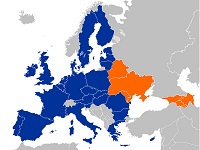1
















| Thumbs Up |
| Received: 33 Given: 0 |

In terms of Armenian Divine Liturgy. Many of the externals are similar to the Western Rite. For example, during prayer separation is done by curtain not icon-stasis (done in Orthodox). You also have the dress of the Priest being closer to the Western rite than Orthodox. Obviously there are differences as well. Though the closest churches to Armenian Apostolic Church is Coptic Church which is like Armenian Apostolic, an anti-Chalcedonian church. (Orthodox Churches accepted Council of Chalcedon). Also, Armenian chant is very important to the liturgy music during service.














| Thumbs Up |
| Received: 71 Given: 0 |

The Armenian name of the Lord
Sign on a marble Khatchkar (Cross Stone) in the Holy Etchmiadzin.
Those familiar with Armenian Churches might have come across a mysterious sign on top of the main altar on numerous occasions. This curious sign “Է” as seen in the picture is the 7th letter of the Armenian alphabet and has a very interesting history. The earliest attestation of the sign has been found on petroglyphs in Metsamor, Armenia (see pictures below) and has been dated to 3.000 BCE. The sign itself was known for it’s use by Mithraic priests in pre-Christian Armenia. Later, during the creation of the Armenian Alphabet (405 A.D.), Mesrob Mashtots incorporated it into the Armenian alphabet and gave it a sacred place as the 7th letter of the alphabet. As such it was adopted by the Armenian Church and to date can be admired on top of the altars of Armenian Churches. Its significance to the Church is well explained by the following article.
If you walk into any given Armenian Orthodox Church, you may notice something over the altar, or at least most of them. You may either see the single letter ‘Eh’ (Է) directly at the top, such as the picture to the left demonstrates, or you may see the words ‘Asdvadz Ser Eh’ (in Armenian letters) with the English translation ‘God Is Love’ following it. In the case of the latter, the letter ‘Eh’ (Է) is still directly above the altar.
What is so special about the letter ‘Eh’ (Է) that it deserves such a prominent place over the church altar? First, let’s look at its meaning. In the phrase ‘God is Love’, the word for is is ‘eh’, thus, ‘Asdvadz Ser Eh’ (transliteration: ‘God Love Is’). So, the letter/word ‘Eh’ (Է) literally means ‘is’ or ‘he is’, which , to those familiar with the Old Testament, may sound like a reference to God Himself.
In Exodus chapter 3, the prophet Moses encountered God in the burning bush. As God was instructing Moses to deliver His people from Egypt, Moses asked, “If I come to the
Altar of the Armenian Church of the Forty Martyrs, Aleppo
Israelites and say to them, ‘The God of your ancestors has sent me to you,’ and they ask me, ‘What is his name?’ what shall I say to them?” God said to Moses, “I am who I am.” He said further, “Thus you shall say to the Israelites, ‘I am has sent me to you.’
God told Moses that His name is ‘I am’, or technically ‘Is’, or ‘He Who Is’. Thus, God is a being who just IS, and it is only the eternal God who can call Himself by this name. In Armenian, it is the letter/word ‘Eh’ (Է) that serves as the name for ‘I am’ or ‘he is’, and just as Moses realized the ‘Eh’ (Է) to be dwelling in the burning bush, so too does the Armenian Church realize that God (Eh) dwells at the church altar.
Furthermore, ‘Eh’ (Է), when pronounced, makes the sound of a breath, and so the idea of God being the breath of life is attached to this letter. Also, the letter ‘Eh’ (Է) happens to be the 7th letter of the Armenian alphabet. Symbolically, 7 is known as the number of perfection, or completion. Throughout the Bible, the number 7 is attributed to several acts of God, and to God Himself, so the letter ‘Eh’ (Է) takes on even further significance.Thus, for the Armenian Church, the letter ‘Eh’ (Է) and its meaning is considered to be Holy. It is not only symbolic, but ‘Eh’ (Է) is the name of God.
Another interesting fact; in the Armenian alphabet, only the letter Է (Ē) can be added as a prefix or a suffix and form a new word. There is no other letter that can be applied in such manner according to the rules of Armenian grammar. Therefore, Է (Ē), is not only a simple letter or a character, but is also a Word in and of itself.
Etymology according to Wikipedia: Old Armenian է (ē), from Proto-Indo-European *h₁es- (“to be”).
Armenian letter Է (Ē) found in Metsamor (3,000 BCE)
Sketch of the Armenian letter Է (Ē) found in Metsamor (3,000 BCE)
Armenian DNA Project
over 300 individuals that have already been tested, revealing that the Armenian branches of DNA are at the root of many branches in Europe.
Armenians belong to 13 distinct genetic groups that go back tens of thousands of years, while at the same time there is no trace of invaders in their DNA in the last 4000 years














| Thumbs Up |
| Received: 12 Given: 0 |













| Thumbs Up |
| Received: 209 Given: 189 |

What magnificent, well crafted churches.
In the late 10th century the Armenian Tiridates was chosen to repair the great dome of Hagia Sophia in Constantinople following severe earthquake damage.
Armenians were the first to use the pointed arch in stone over a century before the Gothic of northern France.
The idea of the pointed arch was probably brought west by Crusaders who had seen the Armenian architecture in Anatolia.
Armenian masons and architects also contributed to European Romanesque architecture.














| Thumbs Up |
| Received: 5 Given: 0 |

Italians' love for knowledge (especially when it comes to art and culture) never seems to impress me.You guys are always the most well informed amongst the tourists on a whole range of things and when Italian groups visit the historical sites in Armenia, they always have their handbooks ready and often times know more than the guides!















| Thumbs Up |
| Received: 71 Given: 0 |

Talking about Italians in Armenian Church history...
Saint Hripsimé Church (Armenian: Սուրբ Հռիփսիմէի եկեղեցի) is one of the oldest surviving churches in Armenia. The church was erected by Catholicos Komitas atop the original mausoleum built by Catholicos Sahak the Great in the year 395 AD that contained the remains of the martyred Saint Hripsimé to whom the church was dedicated. The structure was completed in the year 618 AD. It is known for its fine Armenian architecture of the classical period, which has influenced many other Armenian churches since. This church together with other nearby sites is a UNESCO World Heritage Site, and is located in the present day city of Vagharshapat, (Etchmiadzin), Armenia in the Armavir Province.
History
Saint Hripsimé Church sits on the remains of a pagan structure and also the site where the aforementioned saint was martyred during the time of the conversion of Armenia to Christianity in the year 301 AD. The fifth century Armenian historian Agathangelos wrote that the young and beautiful Hripsimé who at the time was a Christian nun in Rome, was to be forcefully married to the Roman emperor Diocletian. She and the abbess Gayané among other nuns fled the tyrant emperor and left to Armenia. The pagan Armenian King Trdat received a letter from Diocletian in which he described her beauty. Trdat discovered where the nuns were hiding, and fell in love with Hripsimé and later Gayané. After her refusal of his advances, Hripsimé was tortured and martyred at the location of this church, while Gayané was tortured and martyred at a separate location where the church in her name was later built in the year 630. The remaining group of thirty-eight unnamed nuns were martyred at the location of Shoghakat. During the time that Hripsimé was being tortured, Gayané told her to "be of good cheer, and stand firm" in her faith. King Trdat was to be later converted to Christianity and made it the official religion of the kingdom.
Hripsime (1903) S.Nahapet, Venice.
In the early 4th century, Saint Gregory the Illuminator saw a vision in which Christ descended from the heavens, and struck the ground with a golden hammer to level it. In its place he saw the site where Hripsimé was martyred, with a red base symbolizing blood below "columns of clouds, capitals of fire, and on top, a cross of light." In the vision, Christ tells him to erect a memorial to Hripsme in the given place. Saint Gregory was designated to set out the foundations at the location where Hripsimé had been martyred.

Armenian DNA Project
over 300 individuals that have already been tested, revealing that the Armenian branches of DNA are at the root of many branches in Europe.
Armenians belong to 13 distinct genetic groups that go back tens of thousands of years, while at the same time there is no trace of invaders in their DNA in the last 4000 years














| Thumbs Up |
| Received: 12 Given: 0 |

The Khor Virap (Armenian: Խոր Վիրապ, meaning deep pit) is an Armenian Apostolic Orthodox Church monastery located in the Ararat plain in Armenia
Khor Virap with Mount Ararat in background
Khor Virap is probably the most visited pilgrimage site in Armenia for a number of reasons, primarily because it is where Grigor Luisavorich (St. Gregory the Illuminator) was imprisoned for 13 years before curing King Trdat III of a disease. This caused the conversion of the king and Armenia into the first officially Christian nation in the world in the year 301.
The pit where St. Gregory the Illuminator was imprisoned.
Baptism of Tiridates III by St. Gregory.
A chapel was initially built in 642 AD at the site of Kirat Virap by Nerses III the Builder as a mark of veneration to Saint Gregory. Over the centuries, it was repeatedly rebuilt. In 1662, the larger chapel known as the "St. Astvatsatsin" (Holy Mother of God) was built around the ruins of the old chapel, the monastery, the refectory and the cells of the monks. Now, regular Church services are held in this church.
Church interior













| Thumbs Up |
| Received: 14 Given: 0 |

The first thing I notice if we compare Armenian churches to Western ones is that, keep aside the ones build in Armenian communities outside Armenia proper that, more or less has borrowed some foreign look, churches in Armenia basically still have kept their traditional style and all the original forms while Western ones changed very deeply from carolingian to romanesque to gothic and so on.
That means one important thing for those who knows how to read things.
West stressed the importance of experimentalism, the artistic form, and even the importance of a person (the architect, the artist), the neverendin death and reborn of style, that is to say nichilism.
Armenian ones on the other side, didn't care about materialistic stuff like the idolized "art" in the west but instead focused on mantaining tradition therefore cohesion among its people.
And it makes no surprise that today the West has lost almost everything about its identity while a poor isolated long foreign ruled country like Armenia still retain much of it*
*I assume, if wrong correct me.
There are currently 1 users browsing this thread. (0 members and 1 guests)
 Christianity
Christianity
 England
England
 Christianity
Christianity
 Christianity
Christianity
Bookmarks